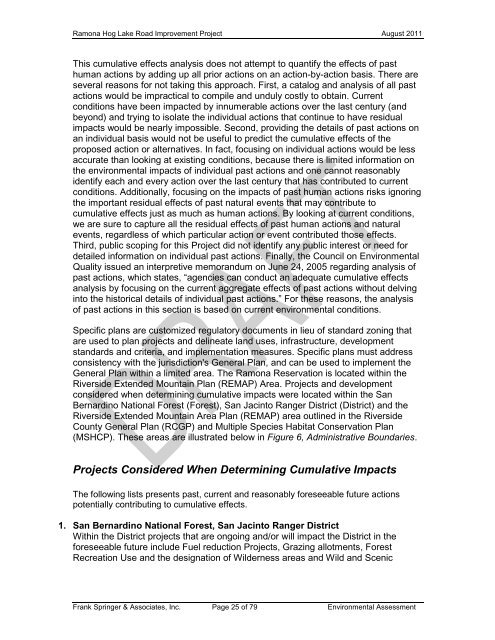environmental assessment for the hog lake road improvement project
environmental assessment for the hog lake road improvement project
environmental assessment for the hog lake road improvement project
You also want an ePaper? Increase the reach of your titles
YUMPU automatically turns print PDFs into web optimized ePapers that Google loves.
Ramona Hog Lake Road Improvement Project August 2011<br />
This cumulative effects analysis does not attempt to quantify <strong>the</strong> effects of past<br />
human actions by adding up all prior actions on an action-by-action basis. There are<br />
several reasons <strong>for</strong> not taking this approach. First, a catalog and analysis of all past<br />
actions would be impractical to compile and unduly costly to obtain. Current<br />
conditions have been impacted by innumerable actions over <strong>the</strong> last century (and<br />
beyond) and trying to isolate <strong>the</strong> individual actions that continue to have residual<br />
impacts would be nearly impossible. Second, providing <strong>the</strong> details of past actions on<br />
an individual basis would not be useful to predict <strong>the</strong> cumulative effects of <strong>the</strong><br />
proposed action or alternatives. In fact, focusing on individual actions would be less<br />
accurate than looking at existing conditions, because <strong>the</strong>re is limited in<strong>for</strong>mation on<br />
<strong>the</strong> <strong>environmental</strong> impacts of individual past actions and one cannot reasonably<br />
identify each and every action over <strong>the</strong> last century that has contributed to current<br />
conditions. Additionally, focusing on <strong>the</strong> impacts of past human actions risks ignoring<br />
<strong>the</strong> important residual effects of past natural events that may contribute to<br />
cumulative effects just as much as human actions. By looking at current conditions,<br />
we are sure to capture all <strong>the</strong> residual effects of past human actions and natural<br />
events, regardless of which particular action or event contributed those effects.<br />
Third, public scoping <strong>for</strong> this Project did not identify any public interest or need <strong>for</strong><br />
detailed in<strong>for</strong>mation on individual past actions. Finally, <strong>the</strong> Council on Environmental<br />
Quality issued an interpretive memorandum on June 24, 2005 regarding analysis of<br />
past actions, which states, “agencies can conduct an adequate cumulative effects<br />
analysis by focusing on <strong>the</strong> current aggregate effects of past actions without delving<br />
into <strong>the</strong> historical details of individual past actions.” For <strong>the</strong>se reasons, <strong>the</strong> analysis<br />
of past actions in this section is based on current <strong>environmental</strong> conditions.<br />
Specific plans are customized regulatory documents in lieu of standard zoning that<br />
are used to plan <strong>project</strong>s and delineate land uses, infrastructure, development<br />
standards and criteria, and implementation measures. Specific plans must address<br />
consistency with <strong>the</strong> jurisdiction's General Plan, and can be used to implement <strong>the</strong><br />
General Plan within a limited area. The Ramona Reservation is located within <strong>the</strong><br />
Riverside Extended Mountain Plan (REMAP) Area. Projects and development<br />
considered when determining cumulative impacts were located within <strong>the</strong> San<br />
Bernardino National Forest (Forest), San Jacinto Ranger District (District) and <strong>the</strong><br />
Riverside Extended Mountain Area Plan (REMAP) area outlined in <strong>the</strong> Riverside<br />
County General Plan (RCGP) and Multiple Species Habitat Conservation Plan<br />
(MSHCP). These areas are illustrated below in Figure 6, Administrative Boundaries.<br />
Projects Considered When Determining Cumulative Impacts<br />
The following lists presents past, current and reasonably <strong>for</strong>eseeable future actions<br />
potentially contributing to cumulative effects.<br />
1. San Bernardino National Forest, San Jacinto Ranger District<br />
Within <strong>the</strong> District <strong>project</strong>s that are ongoing and/or will impact <strong>the</strong> District in <strong>the</strong><br />
<strong>for</strong>eseeable future include Fuel reduction Projects, Grazing allotments, Forest<br />
Recreation Use and <strong>the</strong> designation of Wilderness areas and Wild and Scenic<br />
Frank Springer & Associates, Inc. Page 25 of 79 Environmental Assessment
















